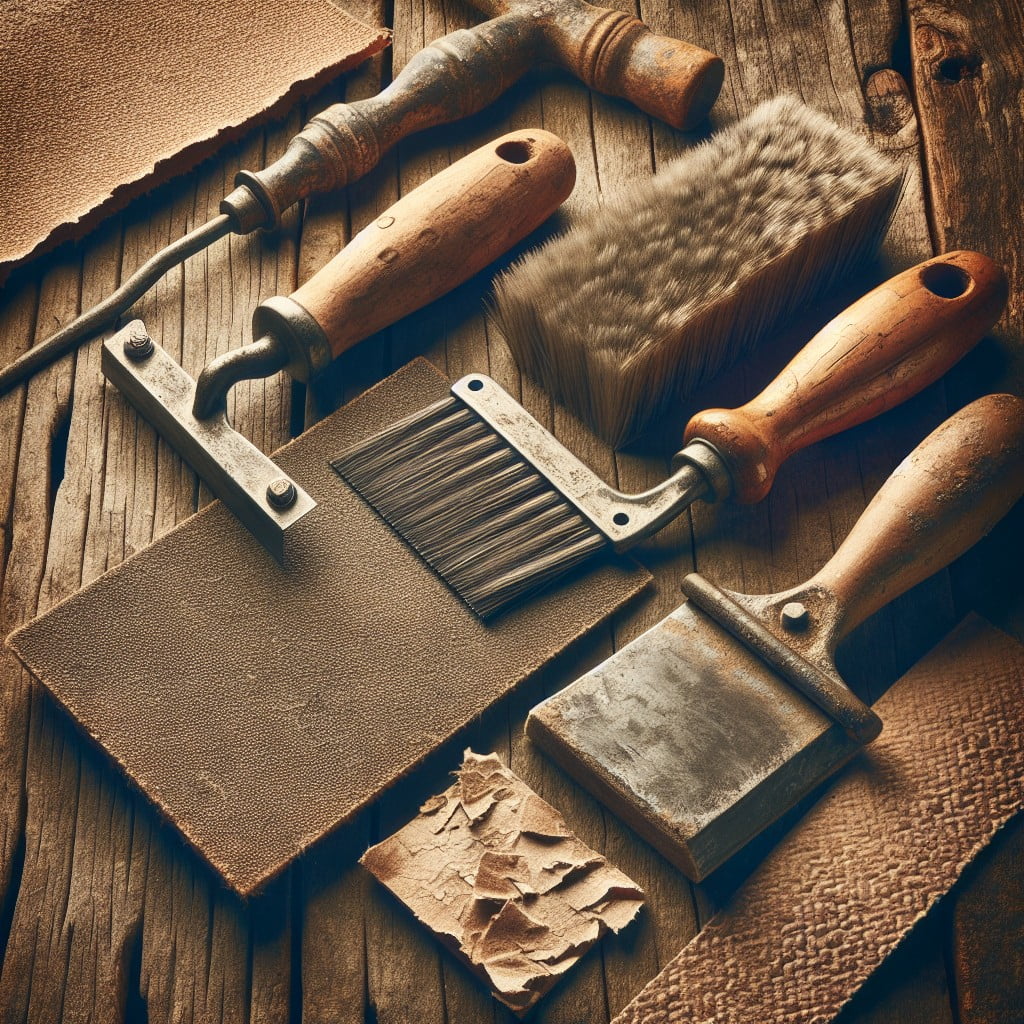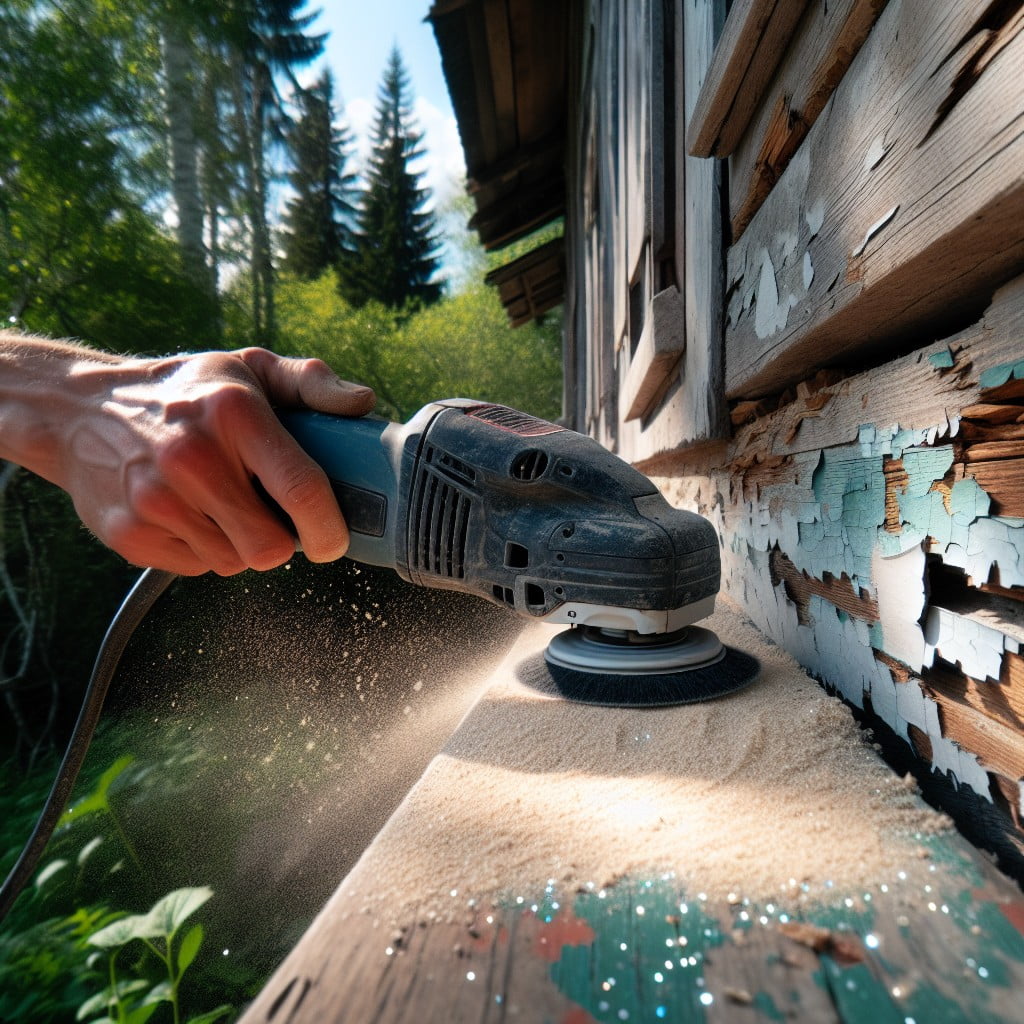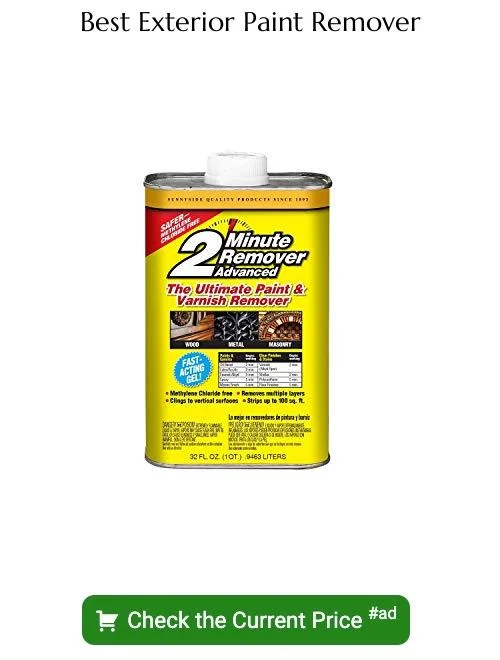Last updated on
Removing exterior paint can instantly refresh the overall appearance of your home, and you’ll surely need to know the process because it’s not as daunting as you may believe.
Key takeaways:
- Acknowledge the risks of exterior paint removal, especially with lead-based paint.
- Use manual tools like scrapers and sandpaper for effective paint removal.
- Consider power tool attachments like wire brushes and paint shavers.
- Electric sanders are efficient for smoothing rough edges and stripping paint.
- Different surfaces require different removal methods, such as infrared paint strippers for wood and gentle heat guns for vinyl siding.
Exterior Paint Removal Warning

Before embarking on a project like removing exterior paint, it’s critical to acknowledge the risks involved. Lead-based paint, commonly used before 1978, poses serious health hazards if not handled properly. Disturbing old layers may release lead particles into the air, which could be harmful if inhaled.
Safety equipment, such as masks, goggles, and gloves, is non-negotiable when dealing with any kind of paint removal. Additionally, local regulations may dictate specific disposal methods for paint debris, making it important to do your research in advance to avoid legal and environmental infractions.
Always test for lead and consult with professionals if unsure about the safety or legality of your project.
Manual Tools for Paint Removal

Scraper tools, often made of metal or plastic, are the stalwarts of manual paint removal. A sharp, flat scraper can efficiently peel off large flakes and sheets of old paint. Detailing scrapers with pointed edges are handy for getting into narrower spots and crevices. For rougher surfaces, wire brushes can be employed to scrub off paint while providing the added benefit of cleaning the underlying surface.
Sandpaper, available in various grits, is used for sanding down rough edges and smoothing out the area after scraping. For larger areas, a sanding block can expedite the process, providing an easier grip and consistent pressure. When using these tools, remember to work in small sections and apply steady, gentle pressure to avoid damaging the wood or substrate beneath the paint layer.
Use protective eyewear and gloves to safeguard against flying paint chips and dust. If dealing with lead-based paint in older buildings, additional precautions should be taken to prevent inhalation or ingestion of hazardous particles.
Power Tool Attachments for Removing Paint

Choosing the right power tool attachment is crucial for efficient paint removal. Wire brushes quickly strip paint from surfaces but may leave scratches, so they’re better suited for rougher areas that will be refinished.
Sanding disks come in various grits; lower grit numbers are more abrasive and strip paint faster but should be used with care to avoid damaging the substrate.
Paint shaver attachments can be highly effective, shaving off layers of paint with precision, though they require a skilled hand to avoid gouging.
For intricate work, detail sanders reach into crevices and moldings where larger tools can’t.
Remember to regularly check the progress and condition of the surface to prevent unintended damage.
Electric Sanders

Equipped with the right grit sandpaper, electric sanders become indispensable for swiftly smoothing down rough edges and stripping peeling paint from exterior surfaces.
Disc, orbital, and belt sanders are the common types found in a DIY enthusiast’s arsenal.
While disc sanders are more aggressive, making them ideal for rapid removal on larger, flat surfaces, orbital sanders offer a gentler touch, suited for fine finishing or working on softer wood that might be damaged by a heavier approach.
To optimize the use of an electric sander, start with a coarse grit to remove the bulk of the old paint, then transition to finer grits for a smooth base ready for a fresh coat.
Always sand in the direction of the wood grain to minimize scratches, and remember that effective dust collection is crucial to maintain visibility and reduce health risks from inhalation of paint particles.
Regular checks of the sander’s abrasiveness ensure consistent performance; once the sandpaper becomes clogged with paint, it’s time to replace it.
Keep in mind that thorough cleanup is essential after sanding to ensure the new paint will adhere properly.
Chemical Paint Removers
When choosing a chemical paint remover, consider the type of surface and the paint’s composition. Chemical strippers come in gel, liquid, or paste forms and contain active ingredients that break down paint for easy removal. Some require a generous application and a waiting period to penetrate and soften the paint. Always use protective gear, such as gloves and a respirator, due to the potent fumes and potential skin irritants.
Apply according to the manufacturer’s instructions and use a paint scraper to gently lift the dissolved paint. Be mindful not to damage the underlying surface. For intricate details or hard-to-reach spots, smaller tools or brushes can aid in the process.
To conclude, always neutralize the chemical action according to the product’s guidance—failing to do so may harm subsequent paint or treatments. Proper disposal of the removed paint and used chemicals is crucial to protect the environment and adhere to local regulations.
Removing Paint With Heat
Heat guns are a popular choice for softening old paint on exterior surfaces, making it easier to scrape away. Held at a distance of a few inches from the painted surface and moved slowly in a back-and-forth motion, heat guns work by emitting hot air which quickly raises the temperature of the paint. This process must be done carefully to avoid damaging the underlying surface or causing the paint to bubble excessively and become difficult to remove.
Infrared paint strippers are another method that uses rays to heat paint and wood simultaneously. This technique minimizes the risk of fire and can be more controlled than using a heat gun.
Safety is paramount when dealing with high temperatures. Always wear protective gloves and eyewear, and ensure the area is well-ventilated. Keep the heat source moving to avoid concentrating the heat in one spot, which could potentially ignite the paint or the substrate. Thermal stripping methods should never be used on lead-based paints due to the toxic fumes that can be released.
After the paint is heated and begins to loosen, use a metal scraper or putty knife to gently lift and remove the softened layers. Dispose of paint waste responsibly to prevent environmental contamination.
Power Washing to Remove Paint
Power washing offers a swift and efficient method to strip away peeling and loose paint from exterior surfaces, particularly on durable materials such as brick and stone. When using a power washer, it’s essential to opt for a unit with adjustable pressure settings—too much force can damage the underlying substrate. Start with a lower pressure and gradually increase as needed.
Always hold the nozzle at a consistent distance from the surface to avoid uneven results. Move in a systematic pattern to ensure complete coverage without causing overlap marks. Safety goggles and protective clothing are recommended to guard against paint chips and debris.
It’s worth noting that power washing may not be effective on paint that is still well-adhered to the surface. Preceding the procedure with a scoring tool can help in such cases. Moreover, power washing is not suitable for all surfaces; softwood, plaster, and other delicate materials might be damaged by the high pressure. Always perform a spot test on a small concealed area before proceeding with the entire job.
Tips for Safe and Effective Paint Removal
Always wear protective gear, including gloves, safety glasses, and a respirator to guard against dust and chemical vapors.
Cover surrounding areas with drop cloths or plastic sheets to protect landscaping and prevent paint chips from contaminating the soil.
Start with the gentlest method first—such as scraping with a plastic putty knife—as more aggressive techniques can damage the underlying surface.
Stay aware of the weather; avoid paint removal in extreme temperatures or humidity levels that can affect the efficiency of certain methods, especially chemical strippers and power washing.
Keep a first-aid kit on hand in case of accidental scrapes or exposure to caustic paint removers.
Dispose of waste responsibly; collect paint chips and leftover chemicals in accordance with local regulations to minimize environmental impact.
When using chemical removers or heat guns, work in small sections to maintain control and ensure thorough removal without overheating or overexposing areas.
Regularly check your progress to apply the least amount of force necessary, reducing the risk of damage to the surface.
If in doubt about the paint removal process or when dealing with lead-based paints, consult a professional for guidance or consider hiring a certified lead abatement contractor.
How to Remove Paint From Different Exterior Surfaces
Wood surfaces benefit most from gentle methods like infrared paint strippers, which minimize damage to the wood grain. When scraping, use a tool like a putty knife at a shallow angle to avoid gouging.
Masonry surfaces, such as brick or stone, require extra care to preserve their integrity. Chemical strippers can be effective, but avoid acid-based products that may erode masonry. Light power washing is also an option, but ensure the pressure is not so high that it damages the surfaces or mortar.
Metal surfaces can handle more abrasive techniques such as sandblasting or the use of a wire brush attachment on a drill. However, these methods come with a risk of scratching or warping, so assess the condition of the metal before deciding on the level of abrasion.
Stucco calls for a delicate approach since it is prone to chipping. Chemical strippers can be used cautiously, and any scraping should be done gently to prevent surface pitting.
Vinyl siding, due to its plastic nature, may warp under high heat, so the preferred method for paint removal is using a solvent designed for plastics or a gentle heat gun coupled with scraping.
For all surfaces, remember to test the removal method on a small, inconspicuous area first to gauge effectiveness and potential surface damage. Use appropriate personal protective equipment and dispose of paint waste according to local regulations.
Environmental and Health Safety Considerations
When dealing with exterior paint removal, it’s essential to prioritize your health and the environment. Lead-based paints, commonly used before 1978, pose serious health risks when disturbed. Therefore, testing for lead before you begin is crucial. If lead is present, federal law requires a certified lead-safe contractor for the job.
Always wear protective gear, including gloves, goggles, and a respirator mask to shield against toxic dust and fumes. If you opt for chemical strippers, choose eco-friendly products to minimize environmental harm. These contain fewer volatile organic compounds (VOCs), making them safer for both you and the surroundings.
Proper disposal of paint waste is just as important. Collect paint chips and residue during removal and dispose of them according to local regulations. This prevents soil and water contamination and avoids harm to local wildlife and ecosystems. Always read and follow manufacturers’ instructions and local laws for disposal of painting materials.
FAQ
What is the fastest way to remove exterior paint?
The fastest way to remove exterior paint is by using mechanical scrapers.
How do you remove paint from an outdoor house?
To remove paint from an outdoor house, one can use a heat gun or an infrared paint remover, which heats up the paint enabling it to peel off effortlessly from the wood, thereby eliminating the need for sanding or usage of chemicals.
How do you remove exterior paint from wood?
To remove exterior paint from wood, begin by using a manual hand sander or power sander with coarse 80-grit sandpaper, apply enough pressure to eradicate the paint but not harm the wood, then move on to medium 150-grit abrasive and conclude with fine 220-grit, ensuring to brush away dust from the surface each time the paper is changed.
What is the best tool to remove exterior paint?
The best tool to remove exterior paint is a putty knife due to its effectiveness, affordability, and less risk of damaging the siding.
What is the most efficient process for removing exterior paint from brick walls?
The most efficient process for removing exterior paint from brick walls involves using a paint stripper, applying it evenly on the painted surface, allowing it to sit for a designated time, and then scraping off the loosened paint carefully.
How can one safely dispose of old exterior paint after removal?
Old exterior paint can be safely disposed of by drying it out completely, placing it into a sealed container, and handing it over to a local waste disposal facility.
Are there eco-friendly alternatives to traditional exterior paint removal methods?
Yes, eco-friendly alternatives to traditional exterior paint removal methods include heat guns, infrared paint strippers, and environmentally friendly chemical strippers.
Recap:





